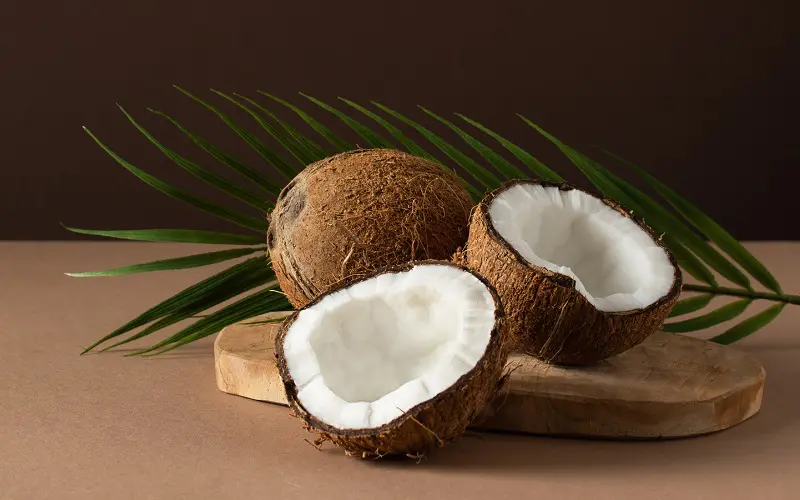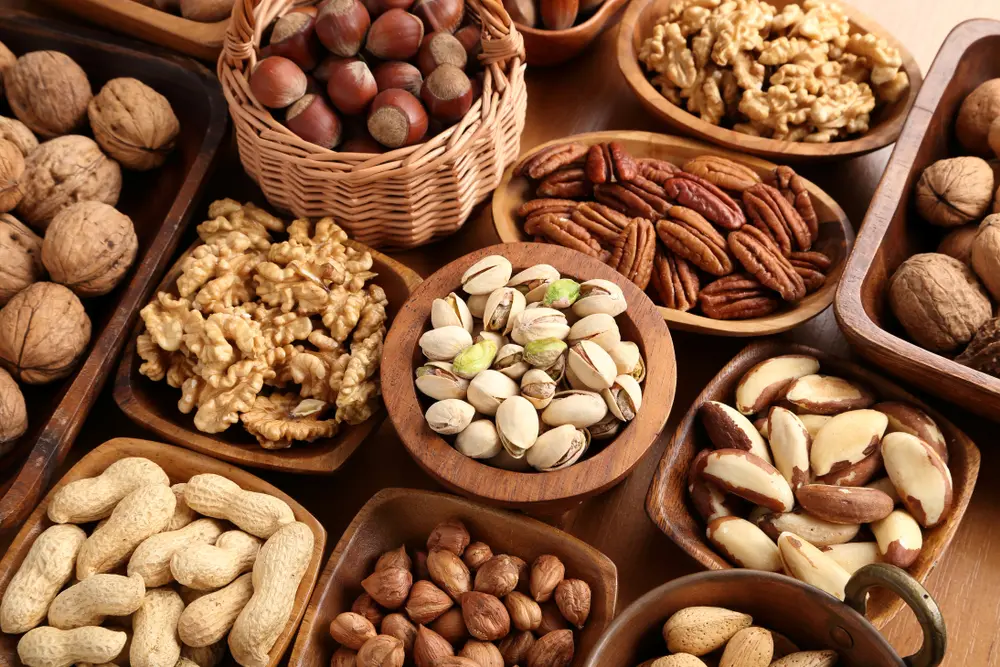Nuts, in simple terms, are typically a type of fruit that grows on trees. But nuts also serve as an umbrella term for non-tree and non-fruit items with similar appearances and nutritional benefits.
In this article, we’ll look at 12 types of nuts and discuss what makes them stand out from the rest.
Types of Nuts: A Summary
There are varying types of nuts, but these are some of the most popular nuts you’ll come across:
- Pine nuts
- Walnuts
- Almonds
- Peanuts
- Acorns
- Pecans
- Cashews
- Pistachios
- Macadamias
- Hazelnuts
- Chestnuts
- Coconuts
12 Different Types of Nuts to Try

Liliya Kandrashevich/Shutterstock
We’ll go over each of these nuts so you can have a more comprehensive understanding of what each of these nuts tastes, their nutritional benefits, and their common uses.
Quick Note: Culinary vs. Botanical Nuts
One thing to understand is that, although the culinary world considers some of these nuts, such as walnuts and coconuts, to be nuts, they are not botanical nuts.A botanical nut is a dried fruit with a single seed and a protective husk over a hard shell.
That’s why peanuts, almonds, cashews, walnuts, pecans, coconuts, and other items that we call nuts are not necessarily botanical nuts but drupes or legumes.
However, some drupes and legumes are called nuts, given their similarities in appearance and taste to what we traditionally think of as nuts. That said, we’ll discuss both botanical and culinary nuts in this article.
1. Pine Nuts

WenPhoto/Shutterstock
Pine nuts come from pine trees, and people harvest them from the cones of these trees. They’re small, white, or cream-colored and have a chewy texture with a slightly sweet flavor.
Pine nuts are a popular ingredient in pesto, and people often use them as a garnish on salads and pasta.
For example, pine nuts taste delicious on pasta with bacon, cheese, and lemon. These nuts are a prime source of protein, fiber, vitamins, and minerals.
They also have a lot of iron and magnesium, which help increase energy levels. However, they’re also relatively high in fat, so you should consume them in moderation.
2. Walnuts

Krasula/Shutterstock
Walnuts are one of the most popular types of culinary nuts and are easily recognizable by their hard, round shells and jagged inner bodies.
Walnuts have a sweet and nutty flavor, and people often use them in baking cakes, bread, and cookies or as a light yet filling snack.
Walnuts are powerful because they are rich in antioxidants and omega-3 oils. They also help decrease inflammation and blood pressure.
3. Almonds

Krasula/Shutterstock
Almonds are another highly popular culinary nut that looks like small, brown stones. Almonds have a slightly sweet and nutty flavor, somewhat similar to walnuts.
People often use almonds in baking because they’re a great source of protein, healthy fats, magnesium, vitamin E, and dietary fiber. Plus, they taste delicious alongside sweet flavors like chocolate and vanilla!
People also often eat almonds as a quick snack on their own or with other nuts, such as in a trail mix. Finally, almonds make a great milk substitute. Almond milk is tasty and creamy, so people use it for cereal, oatmeal, smoothies, and more.
4. Peanuts

dinosmichail/Shutterstock
Peanuts are the number one culinary nut mistaken for a botanical nut, especially given the word “nut” in its name. However, peanuts are not botanical nuts or drupes but are actually legumes.
They grow underground and have thin, brown shells. Peanuts have a mildly sweet flavor but are relatively bland. That’s why people often roast, salt, or glaze them to help bring out their nutty flavor.
You can find peanuts in a variety of dishes, including:
- Soups and stews like West African Peanut Stew
- Noodles like Pad Thai
- Sandwiches like peanut butter and jelly sandwiches
- Snacks like trail mix
- Baked goods like peanut butter cookies
Peanuts are a good source of protein, help lower cholesterol, and have plenty of vitamins B-3 and E.
5. Acorns

ju_see/Shutterstock
Acorns are the botanical nuts of oak trees and have a distinct teardrop shape. They’re brown on the outside with white inner flesh. People do not typically eat acorns raw because of their tannic acid content.
This substance can give acorns a very astringent and bitter flavor. So, before you can eat acorns, you need to remove the tannic acid by leaching them.
Once you leach them, acorns become superfoods that provide phosphorus, calcium, potassium, and other health content. Acorns also have a high amount of vitamin niacin, which helps with energy levels, digestion, and skin health.
People typically use acorns in:
- Flours
- Coffees
- Teas
- Bread and cakes
6. Pecans

gresei/Shutterstock
You might be familiar with pecans from pecan pie and pecan ice cream. This nut goes swimmingly in dessert because of its buttery, slightly sweet flavor. Pecans are the botanical nuts of hickory trees and have a hard outer shell that protects the inner, edible nut.
They look like big almonds with vertical indents, or halfway between an almond and a walnut. Pecans provide a fantastic source of healthy fats, protein, and antioxidants. They’re also an excellent source of calcium and can help lower blood pressure.
Finally, they have particular nutrients that make them even healthier, including:
- Copper: Supports connective tissues and blood vessels
- Thiamine: Helps generate energy from nutrients
- Zinc: Aids the immune system and metabolism
7. Cashews

Krasula/Shutterstock
Cashews are the botanical nuts of cashew trees and have a kidney shape. Manufacturers typically sell them without their shells, which contain urushiol, the same oil that’s in poison ivy.
Cashews have a sweet and nutty flavor, which is why people often use them in sweet dishes, such as desserts and smoothies.
However, they can also be savory, as in curries and stir-fries. Veggies and fruits like cauliflower, broccoli, and cranberries go well with cashews, but so do meats such as beef, chicken, and pork.
Like many nuts, cashews are a good source of protein, fiber, heart-healthy fats, vitamins, and minerals. Plus, they can have a notable impact on brain health and immunity.
8. Pistachios

nelea33/Shutterstock
Pistachios are the culinary nuts and botanical seeds of pistachio trees. They have a characteristic green color. They’re also often sold with their shells still on, which helps with portion control.
Pistachios have a sweet and nutty flavor that goes well in both sweet and savory dishes. You can often find them in desserts, such as baklava, or in Middle Eastern cuisine, such as tabouli.
Pistachios are a fantastic source of fiber, protein, and antioxidants. They’re also linked to weight loss, improved cholesterol levels, and decreased inflammation.
9. Macadamia Nuts

Aedka Studio/Shutterstock
Macadamia nuts are the botanical nuts of macadamia trees and have an oval shape with a hard, green outer shell. The inner flesh of the macadamia nut is white and very creamy.
It has a mild, buttery flavor that makes it a popular ingredient in various desserts, like macadamia cookies, tarts, and cakes. A unique dessert that incorporates macadamia nuts is called a blondie.
A blondie is a type of cookie made with brown sugar and white chocolate, which gives it a lighter flavor than a traditional chocolate chip cookie, and the taste of macadamia nuts pairs incredibly well with white chocolate.
Macadamia nuts are also a good source of healthy fats, fiber, and vitamins. They can support improved gut health and weight loss but are also high in calories, so you don’t need to consume too many to reap these benefits.
10. Hazelnuts

Halil ibrahim mescioglu/Shutterstock
Hazelnuts are the botanical nuts of hazel trees and have a round shape with a smooth, brown outer shell.
The inner flesh of the hazelnut is pale with a sweet and nutty flavor. It often features in desserts, such as hazelnut cookies and cakes, or savory dishes like pesto sauce.
Using hazelnuts for brownies is a popular choice because the sweetness of the hazelnuts enhances the chocolate flavor.
Hazelnuts support healthy digestive systems, weight loss, heart health, insulin sensitivity management, and more.
11. Chestnuts

Lesya Dolyuk/Shutterstock
Chestnuts are the botanical nuts of chestnut trees and have a distinctive, conical shape. They’re brown on the outside with white inner flesh.
The best way to eat chestnuts is to roast them, which brings out their sweet, nutty flavor. You can also puree them into a chestnut cream or add them to stuffing.
Chestnuts have a high level of antioxidants, as well as minerals such as potassium and magnesium. This powerful combination helps fight off cardiovascular diseases.
12. Coconuts

Inna Dodor/Shutterstock
Coconuts are arguably the most unique “nut” on this list. As their name suggests, people often think of coconuts as culinary nuts. However, botanically speaking, coconuts are actually drupes.
Coconuts have a hard, fibrous outer shell that protects the inner white flesh and water. The flesh of coconuts has a slightly sweet yet buttery and woody flavor that goes well in desserts, drinks, and savory dishes.
Coconuts feature prominently in the culinary world and the health and beauty industry, as people often incorporate coconut oil in shampoos, soaps, lotions, and sprays.
Frequently Asked Questions

Krzysztof Slusarczyk/Shutterstock
Here are some commonly asked questions regarding types of nuts.
What nut is not a nut?
Many tree fruits we consider nuts are not actual nuts, botanically speaking. Almonds, pistachios, walnuts, coconuts, and cashews are a few examples of culinary nuts that are actually “drupes.” Drupes are fruits that have a thin, fleshy exterior and a hard pit in the center.
The pit contains the seed of the fruit, which is what we typically think of as the nut. So, while we consider these fruits to be nuts, they’re not technically classified as such. People also view peanuts as nuts, but they are considered legumes.
What are the ten most popular types of nuts?
The ten most popular types of nuts include both culinary and botanical nuts. These are almonds, peanuts, walnuts, pistachios, macadamia nuts, hazelnuts, chestnuts, pecans, pine nuts, and cashews.
What is the unhealthiest nut?
The unhealthiest nut depends on your evaluation of what makes something “healthy.” In terms of calorie content versus protein content, people often consider macadamia nuts the unhealthiest because of their high calories — almost 1000 calories per cup — and relatively low protein makeup.
What are the three healthiest nuts?
As you can see from this article, nuts have a wide range of health benefits. The three healthiest nuts are almonds, pecans, and hazelnuts due to their exceptional amount of minerals and vitamins.
What is the world’s favorite nut?
The culinary nut that people eat most often globally is the peanut. But the most popular tree nut is the almond. Walnuts and cashews follow behind these two most popular nuts.
So, Which Types of Nuts Are Best?
Nuts are fascinating in that they seem so simple and small but pack a mean punch when it comes to flavor, versatility, and health benefits. They often have ample protein, vitamins, antioxidants, heart-healthy fats, and minerals.
Ultimately, you’ll likely enjoy the different taste profiles and health benefits of different types of nuts, depending on the situation.
Now that you understand more about these 12 different types of nuts, which ones are your favorites?

